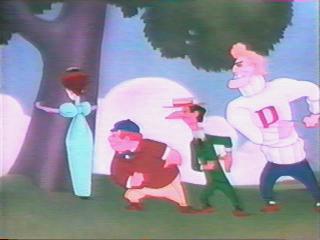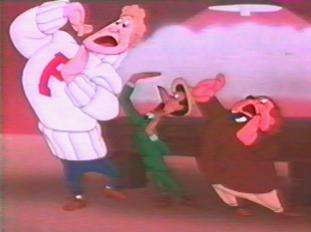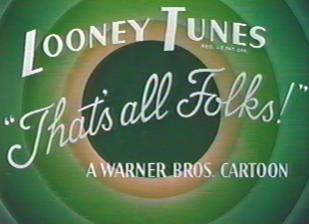The Less Limited Expressive Possibilities of Limited Animation - Part 2
The Second World War in Europe resulted in many artists leaving for the safety of the United States, and their arrival in North America greatly extended their artistic influence. It is impossible to estimate how much they affected American art, but the fact remains that in the 1940s and '50s, the artistic community in American developed a new vision and new artistic vocabulary, known as Abstract Expressionism.
Abstract Expressionism does not describe any one particular style, but rather a general attitude, an outlook characterized by a spirit of innovation and a belief in freedom of expression. So it isn’t difficult to understand how this attitude would be embraced by many in the animation industry who were feeling stifled by the working conditions and the often singular perspective of the Disney world.
To a large degree, Disney’s visions of realism in animation were a blessing and a curse. They certainly had helped to elevate the public perception of animation and to prove that animated films could be more than supporting fillers between feature motion pictures, and the codification of the fundamentals of animation was certainly a benefit as well. But at the same time the labor intensive demands of this style were choking the life out of the cartoon short. Even Disney himself was unable to continue to justify the 7 minute format.
In 1942 prior to the UPA revolution in animation, a landmark cartoon was made by Chuck Jones at Warner Bros called “The Dover Boys” and employed the use of "smear" action where characters go from one pose to another with only a few frames of animation between each position. Many historians believe that “The Dover Boys” was responsible for inspiring John Hubley and the other artists who went on to found UPA years later. How much it directly influenced them is difficult to measure, but it definitely did nothing less than create the modern cartoon.
 Jones initially conceived “The Dover Boys” as an exercise in stylized movement, and created a codex of cartoon shortcuts that would rule Warner Brothers Animation for the next twenty years. The prior standard for movement developed by Disney mirrored normal life. Characters moved across a room in a slow naturalistic style but in “The Dover Boys” the characters are on rocket fuel; the distance from point to point is covered in a blur of a few frames' length, and the character comes to a complete, dead stop to hit the next joke. And the gags are flying by at a breakneck pace. Jones burlesqued the stiffness of nineteenth-century photographs by throwing his characters into ludicrously theatrical poses—bulging arms folded ostentatiously across a manly chest here, maidenly arms raised in demure horror there—and calling attention to those poses by holding them on the screen for much longer than normal. The characters often shoot from one pose to another with only a few frames of film in between. The drawings in those few frames are stretched and even smeared. Disney was focused on bringing respectability to animation while Jones was aiming for freedom of expression.
Jones initially conceived “The Dover Boys” as an exercise in stylized movement, and created a codex of cartoon shortcuts that would rule Warner Brothers Animation for the next twenty years. The prior standard for movement developed by Disney mirrored normal life. Characters moved across a room in a slow naturalistic style but in “The Dover Boys” the characters are on rocket fuel; the distance from point to point is covered in a blur of a few frames' length, and the character comes to a complete, dead stop to hit the next joke. And the gags are flying by at a breakneck pace. Jones burlesqued the stiffness of nineteenth-century photographs by throwing his characters into ludicrously theatrical poses—bulging arms folded ostentatiously across a manly chest here, maidenly arms raised in demure horror there—and calling attention to those poses by holding them on the screen for much longer than normal. The characters often shoot from one pose to another with only a few frames of film in between. The drawings in those few frames are stretched and even smeared. Disney was focused on bringing respectability to animation while Jones was aiming for freedom of expression.
 The background designs for “The Dover Boys” are likewise stylized—unusually simplified for the Schlesinger cartoons, but softened and rounded by airbrush. “The Dover Boys” pulled together successfully elements that were foreign to most of the short cartoons of the early ‘40s: human characters, parody, stylized movement and design. The cartoon was quickly recognized as something out of the ordinary. John Hubley—later a major force at UPA—spoke approvingly in 1942 of how Jones had adapted new animation techniques and new background treatment to a story material that deals with a parody on human behavior, as opposed to the "pure comedy" of the Disney cartoons.
The background designs for “The Dover Boys” are likewise stylized—unusually simplified for the Schlesinger cartoons, but softened and rounded by airbrush. “The Dover Boys” pulled together successfully elements that were foreign to most of the short cartoons of the early ‘40s: human characters, parody, stylized movement and design. The cartoon was quickly recognized as something out of the ordinary. John Hubley—later a major force at UPA—spoke approvingly in 1942 of how Jones had adapted new animation techniques and new background treatment to a story material that deals with a parody on human behavior, as opposed to the "pure comedy" of the Disney cartoons.
Hubley is quoted in a 1942 article in “The Animator” magazine as saying "A progressive, intelligent approach to animation, and realization that it is an expressive medium, is imperative if we want to keep animated cartoons from stagnating. Development and growth of animation is dependent upon varied, significant subject manner presented in an organized form, evolved from elements inherent in the medium. Among the least understood of these elements are the graphic ones.” The animation revolution had truly begun.
 Hubley was not the only artist seeking the future and truth in the animated film at this time. Zack Schwartz, Dave Hilberman and Steve Bostustow founded a studio based on the 'ideal future' of animation. On May 1, 1944, the fast growing company took the name: United Film Production; later it became UPA. This was also the year that John Hubley became a part of the process. The lack of visual details, two dimensional characters, patterned backgrounds, and overlapping color and lines became the UPA trademark look. Inspired by Jones, the animation world became multidimensional in its thinking. Disney made animation a respected filmmaking art, and Chuck Jones opened the doors to freedom of artistic expression.
Hubley was not the only artist seeking the future and truth in the animated film at this time. Zack Schwartz, Dave Hilberman and Steve Bostustow founded a studio based on the 'ideal future' of animation. On May 1, 1944, the fast growing company took the name: United Film Production; later it became UPA. This was also the year that John Hubley became a part of the process. The lack of visual details, two dimensional characters, patterned backgrounds, and overlapping color and lines became the UPA trademark look. Inspired by Jones, the animation world became multidimensional in its thinking. Disney made animation a respected filmmaking art, and Chuck Jones opened the doors to freedom of artistic expression.
If you step back from the disdain that has been heaped on stylized limited animation and view it as one more choice in an endless spectrum of creative possibilities, you can begin to appreciate that there is still significant room for creative and entertaining expression outside the world of fluid realism.
Abstract Expressionism does not describe any one particular style, but rather a general attitude, an outlook characterized by a spirit of innovation and a belief in freedom of expression. So it isn’t difficult to understand how this attitude would be embraced by many in the animation industry who were feeling stifled by the working conditions and the often singular perspective of the Disney world.
To a large degree, Disney’s visions of realism in animation were a blessing and a curse. They certainly had helped to elevate the public perception of animation and to prove that animated films could be more than supporting fillers between feature motion pictures, and the codification of the fundamentals of animation was certainly a benefit as well. But at the same time the labor intensive demands of this style were choking the life out of the cartoon short. Even Disney himself was unable to continue to justify the 7 minute format.
In 1942 prior to the UPA revolution in animation, a landmark cartoon was made by Chuck Jones at Warner Bros called “The Dover Boys” and employed the use of "smear" action where characters go from one pose to another with only a few frames of animation between each position. Many historians believe that “The Dover Boys” was responsible for inspiring John Hubley and the other artists who went on to found UPA years later. How much it directly influenced them is difficult to measure, but it definitely did nothing less than create the modern cartoon.
 Jones initially conceived “The Dover Boys” as an exercise in stylized movement, and created a codex of cartoon shortcuts that would rule Warner Brothers Animation for the next twenty years. The prior standard for movement developed by Disney mirrored normal life. Characters moved across a room in a slow naturalistic style but in “The Dover Boys” the characters are on rocket fuel; the distance from point to point is covered in a blur of a few frames' length, and the character comes to a complete, dead stop to hit the next joke. And the gags are flying by at a breakneck pace. Jones burlesqued the stiffness of nineteenth-century photographs by throwing his characters into ludicrously theatrical poses—bulging arms folded ostentatiously across a manly chest here, maidenly arms raised in demure horror there—and calling attention to those poses by holding them on the screen for much longer than normal. The characters often shoot from one pose to another with only a few frames of film in between. The drawings in those few frames are stretched and even smeared. Disney was focused on bringing respectability to animation while Jones was aiming for freedom of expression.
Jones initially conceived “The Dover Boys” as an exercise in stylized movement, and created a codex of cartoon shortcuts that would rule Warner Brothers Animation for the next twenty years. The prior standard for movement developed by Disney mirrored normal life. Characters moved across a room in a slow naturalistic style but in “The Dover Boys” the characters are on rocket fuel; the distance from point to point is covered in a blur of a few frames' length, and the character comes to a complete, dead stop to hit the next joke. And the gags are flying by at a breakneck pace. Jones burlesqued the stiffness of nineteenth-century photographs by throwing his characters into ludicrously theatrical poses—bulging arms folded ostentatiously across a manly chest here, maidenly arms raised in demure horror there—and calling attention to those poses by holding them on the screen for much longer than normal. The characters often shoot from one pose to another with only a few frames of film in between. The drawings in those few frames are stretched and even smeared. Disney was focused on bringing respectability to animation while Jones was aiming for freedom of expression. The background designs for “The Dover Boys” are likewise stylized—unusually simplified for the Schlesinger cartoons, but softened and rounded by airbrush. “The Dover Boys” pulled together successfully elements that were foreign to most of the short cartoons of the early ‘40s: human characters, parody, stylized movement and design. The cartoon was quickly recognized as something out of the ordinary. John Hubley—later a major force at UPA—spoke approvingly in 1942 of how Jones had adapted new animation techniques and new background treatment to a story material that deals with a parody on human behavior, as opposed to the "pure comedy" of the Disney cartoons.
The background designs for “The Dover Boys” are likewise stylized—unusually simplified for the Schlesinger cartoons, but softened and rounded by airbrush. “The Dover Boys” pulled together successfully elements that were foreign to most of the short cartoons of the early ‘40s: human characters, parody, stylized movement and design. The cartoon was quickly recognized as something out of the ordinary. John Hubley—later a major force at UPA—spoke approvingly in 1942 of how Jones had adapted new animation techniques and new background treatment to a story material that deals with a parody on human behavior, as opposed to the "pure comedy" of the Disney cartoons.Hubley is quoted in a 1942 article in “The Animator” magazine as saying "A progressive, intelligent approach to animation, and realization that it is an expressive medium, is imperative if we want to keep animated cartoons from stagnating. Development and growth of animation is dependent upon varied, significant subject manner presented in an organized form, evolved from elements inherent in the medium. Among the least understood of these elements are the graphic ones.” The animation revolution had truly begun.
 Hubley was not the only artist seeking the future and truth in the animated film at this time. Zack Schwartz, Dave Hilberman and Steve Bostustow founded a studio based on the 'ideal future' of animation. On May 1, 1944, the fast growing company took the name: United Film Production; later it became UPA. This was also the year that John Hubley became a part of the process. The lack of visual details, two dimensional characters, patterned backgrounds, and overlapping color and lines became the UPA trademark look. Inspired by Jones, the animation world became multidimensional in its thinking. Disney made animation a respected filmmaking art, and Chuck Jones opened the doors to freedom of artistic expression.
Hubley was not the only artist seeking the future and truth in the animated film at this time. Zack Schwartz, Dave Hilberman and Steve Bostustow founded a studio based on the 'ideal future' of animation. On May 1, 1944, the fast growing company took the name: United Film Production; later it became UPA. This was also the year that John Hubley became a part of the process. The lack of visual details, two dimensional characters, patterned backgrounds, and overlapping color and lines became the UPA trademark look. Inspired by Jones, the animation world became multidimensional in its thinking. Disney made animation a respected filmmaking art, and Chuck Jones opened the doors to freedom of artistic expression.If you step back from the disdain that has been heaped on stylized limited animation and view it as one more choice in an endless spectrum of creative possibilities, you can begin to appreciate that there is still significant room for creative and entertaining expression outside the world of fluid realism.

1 Comments:
What a bloomer - I meant Abstract Expressionism, of course!
Marian Kelly
emkay@dwf.homeip.net
Post a Comment
<< Home